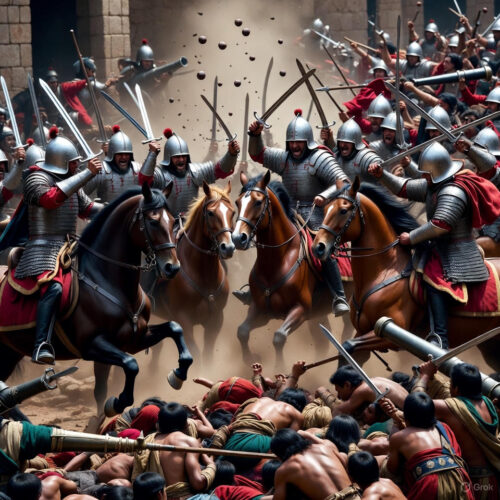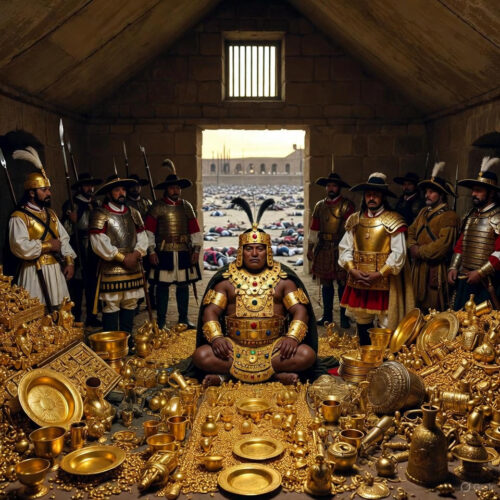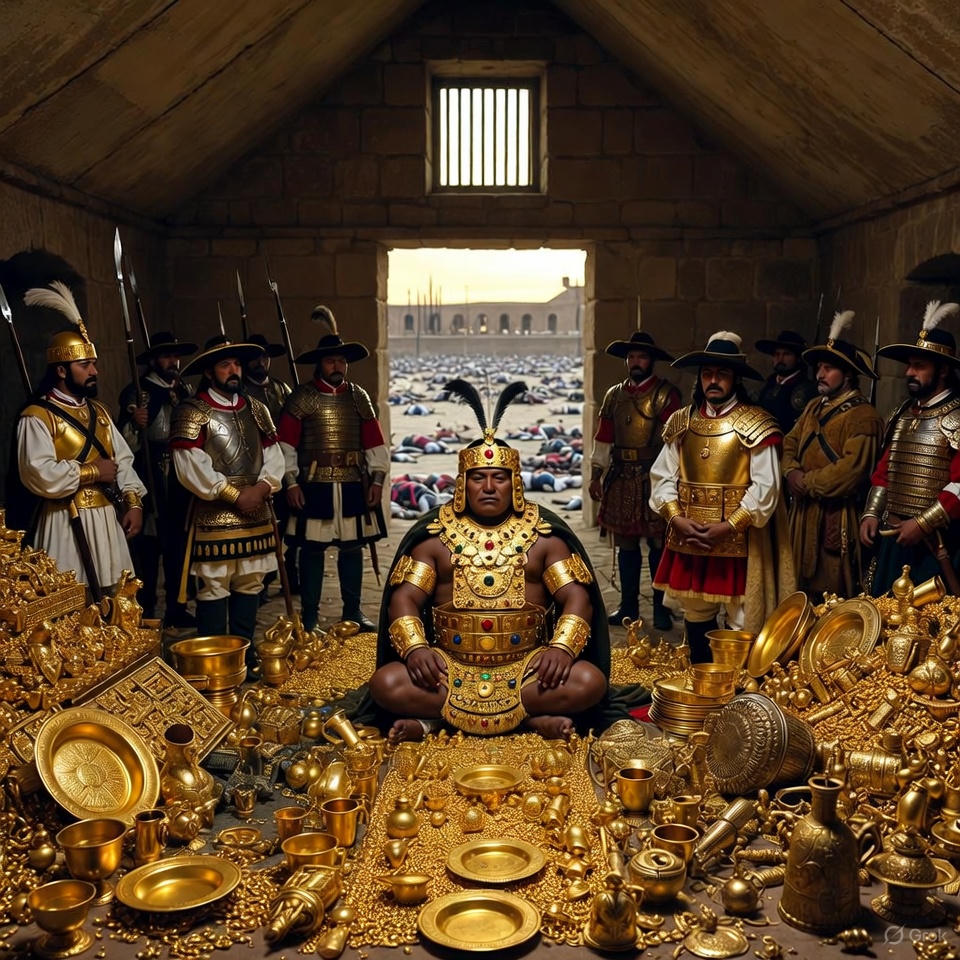Imagine a crisp Andean morning where the fate of an entire civilization hung by a thread—or rather, by the glint of steel and the thunder of hooves. On November 16, 1532, in the highland town of Cajamarca, Peru, a small band of Spanish adventurers led by Francisco Pizarro executed one of history’s most audacious ambushes, capturing Inca emperor Atahualpa and setting in motion the collapse of the mighty Inca Empire. This wasn’t just a battle; it was a seismic shift that blended cunning strategy, technological disparity, and sheer audacity, forever altering the course of South American history. In this blog, we’ll dive deep into the riveting details of that day, exploring the intricate web of events that led to it, the chaos that unfolded, and the far-reaching consequences. Then, we’ll bridge the centuries to uncover how the lessons from this pivotal moment can fuel your personal growth today, turning historical insight into actionable motivation. Buckle up—this is a tale of empires clashing, underdogs triumphing, and timeless wisdom waiting to be applied.
To truly grasp the significance of November 16, 1532, we must first journey back to the world that birthed the Inca Empire. The Incas, known as the Tawantinsuyu or “Realm of the Four Parts,” were a marvel of pre-Columbian engineering and organization. Emerging from the Cuzco Valley around the 12th century, they expanded rapidly under leaders like Pachacuti Inca Yupanqui in the mid-15th century. By the time of Atahualpa’s reign, the empire stretched over 2,500 miles along the western coast of South America, from modern-day Colombia to Chile, encompassing diverse terrains from coastal deserts to Amazonian jungles and Andean peaks. This vast domain was home to an estimated 10 to 12 million people, unified not by brute force alone but by an ingenious system of administration.
The Incas’ success stemmed from their mastery of agriculture and infrastructure. They terraced steep mountainsides to create arable land, cultivating potatoes, maize, quinoa, and other crops that sustained their population. Their road network, the Qhapaq Ñan, spanned over 25,000 miles, rivaling the Roman Empire’s in scale and efficiency. Messengers, or chasquis, relayed information across this network at astonishing speeds, covering up to 150 miles a day. Socially, the empire operated on a labor tax system called mit’a, where citizens contributed to public works like building temples or maintaining irrigation canals. Religion played a central role, with the Sapa Inca (emperor) seen as a divine descendant of Inti, the sun god. Temples like the Coricancha in Cuzco were plated in gold, symbolizing the empire’s wealth from mines in the Andes.
But cracks were forming. In the late 1520s, a civil war erupted between half-brothers Huáscar and Atahualpa after the death of their father, Huayna Capac, who succumbed to a mysterious illness—likely smallpox introduced by European explorers. Huáscar ruled from Cuzco in the south, while Atahualpa commanded the northern armies from Quito. The war was brutal, involving massive battles and sieges, with Atahualpa emerging victorious just months before the Spanish arrival. His forces captured Huáscar near Cuzco, but the conflict left the empire divided and exhausted, its armies scattered and resources strained. This internal strife would prove fateful, as it prevented a unified response to the foreign invaders.
Meanwhile, across the Atlantic, Europe was in the throes of the Age of Exploration. Christopher Columbus’s 1492 voyage had opened the New World to Spanish ambition, leading to conquests in the Caribbean and Mexico. Francisco Pizarro, a seasoned soldier born around 1475 in Trujillo, Spain, was no stranger to adventure. Illegitimate son of a colonel, he had fought in Italy and sailed with explorers like Vasco Núñez de Balboa, witnessing the Pacific Ocean in 1513. Inspired by Hernán Cortés’s conquest of the Aztecs in 1521, Pizarro sought his own glory. After two failed expeditions to Peru in 1524 and 1526—plagued by storms, hunger, and hostile natives—he secured royal backing from King Charles I in 1529. The Capitulación de Toledo granted him governorship over any lands conquered, along with permission to recruit.
Pizarro’s third expedition set sail from Panama in January 1531 with just 180 men, 27 horses, and a few cannons. This ragtag group included his brothers Hernando, Juan, and Gonzalo, plus hardened veterans like Sebastián de Benalcázar and Diego de Almagro (though Almagro joined later). They were motivated by tales of gold-rich lands, spread by indigenous traders. Landing at Tumbes in northern Peru, they found the town in ruins from the civil war. Undeterred, they marched south, establishing San Miguel de Piura as a base. Along the way, they encountered Inca scouts and learned of Atahualpa’s victory. Pizarro’s men were a mix of infantry with swords, pikes, and crossbows; cavalry on armored horses; and a few arquebusiers with primitive firearms. Their steel armor and weapons far outmatched Inca cotton padding and bronze tools.
The trek to Cajamarca was arduous. Crossing rivers, deserts, and the treacherous Andes via mountain passes over 13,000 feet high, the Spaniards endured cold, altitude sickness, and skirmishes. They arrived in the Cajamarca valley on November 15, 1532, gazing upon a town of stone buildings and hot springs, surrounded by Atahualpa’s encampment of 40,000 to 80,000 warriors. Atahualpa, fresh from his triumph over Huáscar, was resting at the baths outside town, his army a formidable force armed with slings, clubs, spears, and bolas. Yet, he underestimated the strangers, viewing them as curiosities—bearded men on “large llamas” (horses). Messengers had described the Spaniards as gods or raiders, but Atahualpa chose diplomacy, inviting Pizarro to meet.
That night, Pizarro hatched his plan in Cajamarca’s main plaza, a large square flanked by long halls. Inspired by Cortés’s capture of Montezuma, he decided on an ambush. His 168 men—106 foot soldiers, 62 cavalry—hid in buildings around the plaza, with cavalry in side streets and artillery positioned strategically. Friar Vicente de Valverde would lead the “requerimiento,” a ritual demand for submission to the Spanish crown and Christianity. Atahualpa, confident in his numbers, agreed to visit unarmed, bringing 5,000 to 7,000 attendants—nobles, priests, and servants—while leaving his main army camped outside.
On the afternoon of November 16, Atahualpa approached in splendor. Carried on a golden litter by 80 lords in blue livery, he wore a crown of emeralds and a necklace of massive emeralds. His procession included dancers, musicians with conch shells, and squads sweeping the path. The plaza seemed empty as they entered, filling it with colorful regalia. Pizarro’s men, peering from hiding, were awestruck and terrified. Valverde advanced with a Bible and interpreter Felipillo, reciting the requerimiento. Atahualpa, puzzled, took the book, examined it, and tossed it aside, reportedly saying, “I will be no man’s tributary.” This was the signal.
Chaos erupted. Cannons boomed, trumpets blared, and cavalry charged from concealment, shouting “Santiago!” The horses, unknown to the Incas, caused panic, trampling crowds. Spanish steel swords slashed through Inca defenses; arquebuses fired volleys, their smoke and noise amplifying terror. The Incas, unarmed except for ceremonial weapons, were slaughtered in the confined space. Walls trapped them as they tried to flee, some piling bodies to climb over. Atahualpa’s litter bearers died protecting him, but Pizarro himself rushed in, grabbing the emperor’s arm to prevent his killing—valuable alive for ransom. The massacre lasted about 30 minutes to two hours, killing 2,000 to 7,000 Incas with no Spanish fatalities, only minor wounds.
What made this victory possible? Technology played a key role: steel vs. bronze, guns vs. slings, horses vs. foot soldiers. But strategy was paramount. Pizarro exploited surprise, the plaza’s layout, and Inca protocol. The civil war had weakened morale, and Atahualpa’s hubris—refusing to arm his men—sealed the fate. Cultural misunderstandings abounded; Incas fought to capture enemies alive for sacrifice, while Spaniards aimed to kill. Disease, too, lurked in the background—smallpox had ravaged the empire, killing Huayna Capac and fueling the civil war.
In the immediate aftermath, Atahualpa was imprisoned in a room he famously offered to fill with gold once and silver twice for his release. Over the next months, treasures poured in: 13,000 pounds of gold and 26,000 pounds of silver, worth millions today. But Pizarro, fearing rescue, tried Atahualpa for idolatry, polygamy, and Huáscar’s murder. Convicted, he was garroted on July 26, 1533, after converting to Christianity to avoid burning. This sparked resistance, but the Spanish pressed on, capturing Cuzco in 1533 with Inca allies disillusioned by Atahualpa.
The conquest unleashed horrors: enslavement, forced labor in mines, and epidemics that decimated 90% of the indigenous population. Spanish infighting followed, with Almagro’s rebellion and Pizarro’s assassination in 1541. Yet, it flooded Spain with wealth, fueling European wars and inflation. Culturally, it blended worlds—Quechua words entered Spanish, Andean crops like potatoes transformed global diets. The Inca legacy endures in Peru’s ruins, like Machu Picchu (rediscovered 1911), and indigenous traditions.
Delving deeper, let’s examine the key figures. Francisco Pizarro, illiterate but shrewd, embodied the conquistador spirit—ruthless ambition tempered by calculation. His early life as a swineherd honed survival skills. Atahualpa, born around 1500, was a brilliant general who unified the north but lacked his father’s diplomacy. His capture exposed Inca vulnerabilities: a centralized authority that crumbled without the emperor. Supporting players like Hernando Pizarro, who sailed back with treasure to secure reinforcements, and interpreter Felipillo, whose mistranslations may have escalated tensions, added layers.
The battle’s tactics merit scrutiny. Pizarro divided his forces: 20 cavalry under Hernando to charge first, infantry to follow, cannons to disorient. Inca warriors, elite but unarmored, used macanas (clubs) and huaracas (slings) effectively in open fields but not in urban ambush. Eyewitness accounts from Pedro Pizarro (Francisco’s cousin) and others describe the terror: Incas clawing at walls, Spaniards’ horses slipping on blood.
Broader context: This was part of the Columbian Exchange, transferring goods, ideas, and diseases. Old World horses revolutionized New World warfare; New World gold bankrolled the Habsburgs. Religiously, the requerimiento justified conquest under the Doctrine of Discovery, papal bulls dividing the world between Spain and Portugal.
Post-conquest, the Viceroyalty of Peru became Spain’s richest colony, with Potosí’s silver mines producing 60% of global supply. Indigenous resistance persisted—Manco Inca’s 1536 siege of Cuzco nearly succeeded, and Tupac Amaru’s 1572 rebellion echoed defiance. By the 18th century, mestizo cultures emerged, blending European and Andean elements.
Historians debate the battle’s ethics: Was it genius or genocide? Jared Diamond’s “Guns, Germs, and Steel” attributes Spanish success to environmental factors; others highlight Inca disunity. Primary sources like Guamán Poma de Ayala’s chronicle offer indigenous perspectives, decrying atrocities.
Now, shifting gears to motivation—while the historical saga dominates our tale, the Battle of Cajamarca offers profound lessons for today. It teaches that preparation, adaptability, and bold action can overcome seemingly insurmountable odds. In a world of rapid change, like Pizarro’s crew facing an empire, you can harness strategy to conquer personal challenges.
Here’s how this historical fact benefits you individually:
– **Embrace Strategic Planning in Uncertainty**: Pizarro’s ambush succeeded through meticulous setup despite inferior numbers. In your life, map out goals with contingencies—whether job hunting or starting a business—to turn disadvantages into wins.
– **Leverage Technology and Knowledge Gaps**: Spanish guns and horses shocked the Incas. Today, upskill in AI, coding, or niche expertise to gain edges in your career, outpacing competitors like a modern conquistador.
– **Overcome Hubris with Humility**: Atahualpa’s underestimation cost him everything. Cultivate self-awareness; seek feedback regularly to avoid blind spots in relationships or projects.
– **Build Alliances Amid Division**: The civil war weakened the Incas, allowing Spanish exploitation. Foster networks in your community or workplace to create support systems that amplify your efforts.
– **Turn Setbacks into Ransoms of Opportunity**: Atahualpa’s gold-filled room bought time, though briefly. When facing failure, negotiate—pivot careers or renegotiate debts—to extract value and rebound stronger.
To apply this, follow this step-by-step plan:
- **Research Your ‘Empire’**: Spend 30 minutes daily studying your goal’s landscape, like Pizarro scouting Peru. Identify obstacles and advantages.
- **Assemble Your ‘Crew’**: Recruit mentors or peers for support, mirroring Pizarro’s brothers. Schedule weekly check-ins.
- **Plan the ‘Ambush’**: Break goals into surprise actions—e.g., launch a side hustle unexpectedly after preparation.
- **Execute with Boldness**: Take the leap, adapting on the fly like the cavalry charge.
- **Reflect and Ransom Wins**: After action, evaluate outcomes, celebrating gains to fuel momentum.
This historical gem reminds us: Empires rise and fall, but personal empires are built daily. Let Cajamarca inspire you to charge forward!

